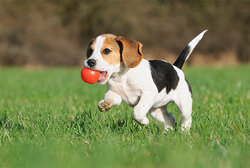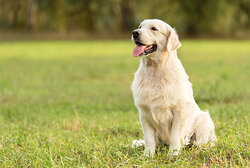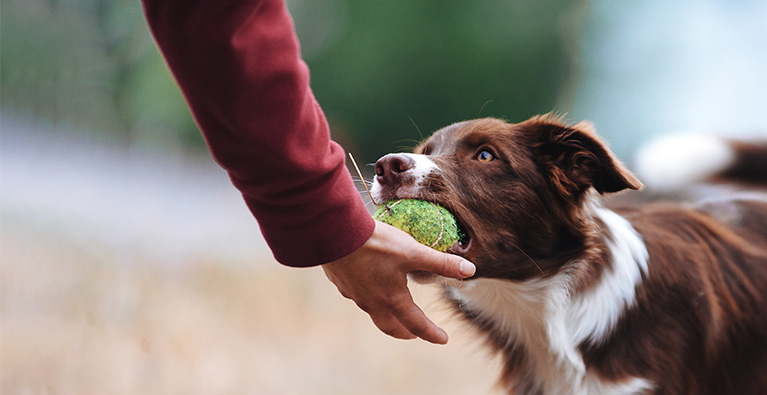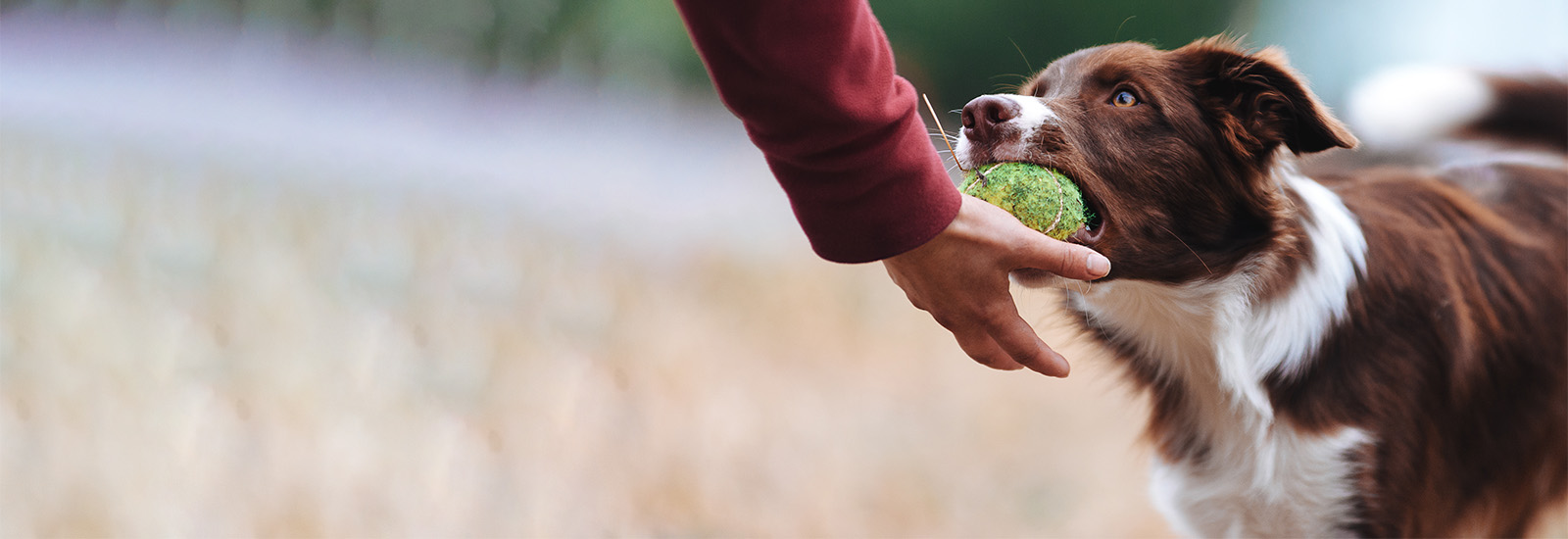Teaching a dog the command “Drop it!”
Teaching your dog the command "Drop It!" is very important, particularly if you are, for example, taking your dog for a walk and it suddenly has a live animal or even something rotten or poisonous in its mouth, which it needs to let go of as soon as possible.
The command “Drop it!” can be very useful
Many puppy owners soon discover the advantages of having their puppy master the “Drop it!” command. This is the case, for example, when the little one is busy chewing on their favourite slipper, taking off with one of your socks, nibbling on a plastic object or a cable, or eating something that is unfit for consumption. And outdoors there are always dangers present. Sadly, not all people have good intentions towards dogs. Every year pets die because dog haters have put out poisoned food. A dog that has mastered the command “Drop it!” can be prevented from swallowing toxic bait, decayed animal remains, or faeces, and thus saved from being poisoned.
The command “Drop it!” is especially important for breeds of dogs that tend to eat anything they find lying on the ground. However, ex-shelter dogs that may have had to fight for survival on the streets and eat almost anything in the past are also particularly at risk. To be on the safe side, every dog should be taught at an early stage to drop something voluntarily.
The difference between “Drop it!” and “No”!
The commands “Drop it!” and “No!” are similar, but a distinction should be made between them. “No!” means that the dog should stop a certain behaviour. The command “Drop it!” requires the dog to release something from its mouth immediately. As described above, this can be a matter of life and death. This is why it is important that every dog learns this command.
Practising “Drop it!” with your puppy
Before we explain the concept of the "Drop it!" command, puppy owners should remember that their pets have a very short span of attention. They can often only concentrate for one or two minutes before they have something completely different on their mind. There is then no point in trying to force them to continue practising. This will simply be too much for them. Most importantly, you should bear in mind that the command “Drop it!” is not as easy as, for example, “Down!”. After all, it is about releasing, for example, a beloved chew toy or a bone from its jaws. Most puppies will have learned what the consequence of this can be from their siblings. They grab the object and it is gone. Over time, puppies learn to hold on more tightly to things that they like.
How can I teach my dog the command “Drop it!”?
- Have treats ready
You will rarely find a dog that does not love treats. You can therefore rest assured that these will get your dog’s full attention. And that is, after all, what we want during training sessions. You should therefore have a bag of tasty treats ready. These are particularly important for the “Drop it!” command, because they not only serve as a reward, but should also be used as a bartering tool. This will, however, not work if they are less interesting than the object that the dog is chewing on at the moment. You should therefore equip yourself with some particularly tasty snacks. -
Choose the right time and place
When teaching your dog any new command, it is important to carefully choose the right time and place. Even the most delicious treats may be uninteresting to your pet if it has just eaten and is really full, tired or worn out. Therefore, choose a time at which you think your dog will be receptive and keen to engage in activities with you. It is an advantage if there are as few distractions as possible in the surroundings. A busy dog park is not suitable for this purpose. The ideal place is at home, in your own garden or in an outdoor environment that is as free from stimuli as possible. - Practising the command “Drop it!” with a tugging toy
A very effective way of practising the command "Drop it!" is with a game of tug. This will, however, only work if your dog likes this type of game. You can then encourage your pet to interact with you by means of, for example, a tugging rope. Here, you hold the rope with your hand, and your dog holds it with its mouth. After a while you suddenly let go. Many dogs will quickly lose interest without an opponent and release the object. This is the moment when you give the command “Drop it!” and reward your pet with a treat. The dog will not understand the connection at first. This requires time and practice. So start again from the beginning if possible. Every time your dog lets go of the toy, immediately say “Drop it!” and give your pet a reward. Dogs are intelligent creatures and will keep trying to get treats. There is therefore a good chance that your dog will sooner or later understand that the command “Drop it!” means that you want it to release an object from its mouth – and that it will then get a delicious reward. -
You can practise “Drop it!” with any object.
You can usually teach dogs the command “Drop it!” relatively quickly with a chewing rope. This can, however, also be done with a toy or chew bone. But it should not be your pet’s absolute favourite toy or a particularly appealing chew bone. After all, you want to show your dog that it is worthwhile for it to surrender something. And this will only work if the reward is irresistible to your pet. So have plenty of great-tasting treats ready and get ready to start.
A good moment is, for example, when the dog is chewing on a soft toy. It will certainly be enjoying this, but there is a good chance that it will be prepared to immediately let it go in exchange for a snack. Go up to your dog, show it the reward and give the command “Drop it!” as soon as it releases the toy from its mouth. You can also do this with a piece of wood or a chew bone. You should, however, wait until the dog has already been able to satisfy its chewing instinct a little before you suggest the swap. You can also attempt to gently take the bone out of its mouth. The dog should not show any aggression! Give it the reward and then give it back the bone. If possible, practise this again right away or later on. -
Practice makes perfect
As with any command, it will take time to put it into practice. Remember that this is not simply about “Down!” or “Sit!”; instead the dog has to learn to release something that it finds interesting. This takes time and patience. If you want to see results, you need to practise frequently. You can then gradually increase the demands. Start by not immediately holding the treat right in front of your dog’s nose as an exchange, but instead give the command first, and only when your pet has obeyed, show and give it the reward.
You can further increase the difficulty level of the training by requiring your dog to hand over its favourite toy, for example, or by creating further distractions all around it. Gradually increase the level of difficulty to ensure that you are prepared for the worst possible situation. This occurs when a dog disappears into the bushes while being walked and comes out holding something in its mouth. The dog should let go of the object as quickly as possible when it hears the command “Drop it!”, because in the worst case it could be a poison bait. By the time such a situation occurs, every dog owner will be glad that they have trained their pet to be obedient.
Video about the command “Drop it!”.
Would you like to see the use of the command “Drop it!” on video? Animal trainer Fränzi Lüttich demonstrates how it works with dachshund Polly:
You may also like this

Teaching your dog the commando "Down"
“Down!” is one of the most important commands a dog should master

Teaching your dog to fetch
Fetching is an ideal activity for dogs

Teaching your dog to sit
How to teach your dog to sit

Lead training
We show you how you can train to walk properly on a lead





